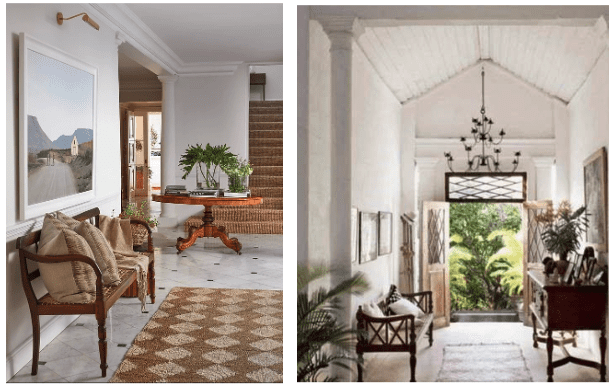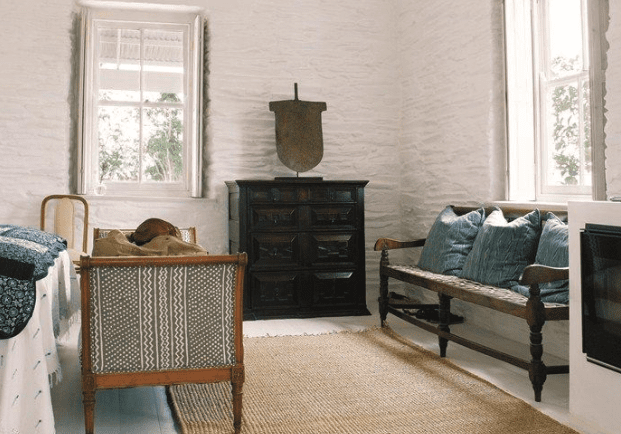Growing up in South Africa means certain antique furniture pieces are part of our historical DNA. One such item is the much-loved Riempie bench; a staple in homes since Jan Van Riebeeck’s arrival in the Cape of Good Hope in 1652. As the Dutch settlement grew, so did their need for furniture. Qualified woodworking artisans started making furniture and passing on their skills to the local indigenous peoples who started producing various copies of Indo-Dutch, French and German-style pieces.
Introducing a piece of South Africa’s heritage
The South African Riempie bench became a design adaptation when local carpenters replaced the cane or reed seating with ‘riempies’ (thin strips of cured leather). These riempies were more easily obtainable and more durable than their imported woven counterparts.
The crafting of Riempie benches is a labour-intensive process that has been passed down through generations. Skilled artisans carefully weave the riempie leather strips across the frame, creating a strong, comfortable and visually distinctive seat.
The Riempie ‘stoel’ then became popular among the 1820 British settlers who were on the move and needed sturdy but lightweight chairs that utilised materials that were readily available. It wasn’t long before Riempie benches and chairs were to be found in most of our ancestors’ homes as timeless South African classics.
Blending history with modern interior design
The functional design of Riempie benches and chairs makes them one of the easiest antique additions in contemporary spaces. They just work in so many different set-ups: in hallways, at a dining table, as a desk chair, or perched at the end of a bed.

As versatile antiques, Riempie benches and chairs have not lost their charm or investment value. Delightful examples are the ‘Tolletjie’ (spindle) chair – dating back to the 17th century – often made from Cape Stinkwood, Cape Keurboom or Yellowwood (boasting turned elements and interwoven riempies for the seat), and 19th-century Tulbagh transitional chairs. It’s fair to say that Riempie benches have their design ‘roots’ deeply embedded in South African history.
The riempies are also incredibly strong, and if they become worn over time, can simply be replaced. The weaving together of the untanned leather strips for the seat is a unique design feature and makes any space that these antique Riempie benches inhabit feel light and airy.
Incorporating Riempie benches into your decor
Choose the right Riempie piece: When selecting an antique Riempie bench or chair, consider the existing colour palette, proportions and style of your space. Up the ante by bleaching, staining or painting them to become fun contemporary conversation pieces.

Mix the old with new: One of the most captivating aspects of Riempie furniture is its ability to blend seamlessly with modern design. Pair an antique Riempie bench with sleek, contemporary furniture to create a striking contrast.
Create a focal point: Positioning your Riempie bench strategically will make it a statement piece in the room. Its unique texture and design craftsmanship will draw the eye, adding cultural character, warmth and a touch of ‘South Africana.’
Accessorise thoughtfully: Let Riempie pieces become the ‘base’ or backdrop for complementary furniture pieces and accessories: rustic throws, tribal-inspired cushions, wooden side tables or standing lamps.
Shopping locally for antique Riempie furniture
The Crown Collection – South Africa’s largest emporium of handpicked antiques – is the obvious starting point to furnish your space with a Riempie bench or a couple of Riempie occasional chairs. Or go all out and buy a set of antique Riempie chairs to be the traditional seating options for a modern dining room table.
Furniture trends may come and go, but the Riempie bench will always be a timeless South African classic that connects the past with the present and adds a nostalgic decor narrative to modern homes and lifestyles.
Pop in online – or in-studio at 20 Ballyclare Drive, Bryanston – to view our collection of Riempie benches and chairs.


 Whatsapp us now
Whatsapp us now